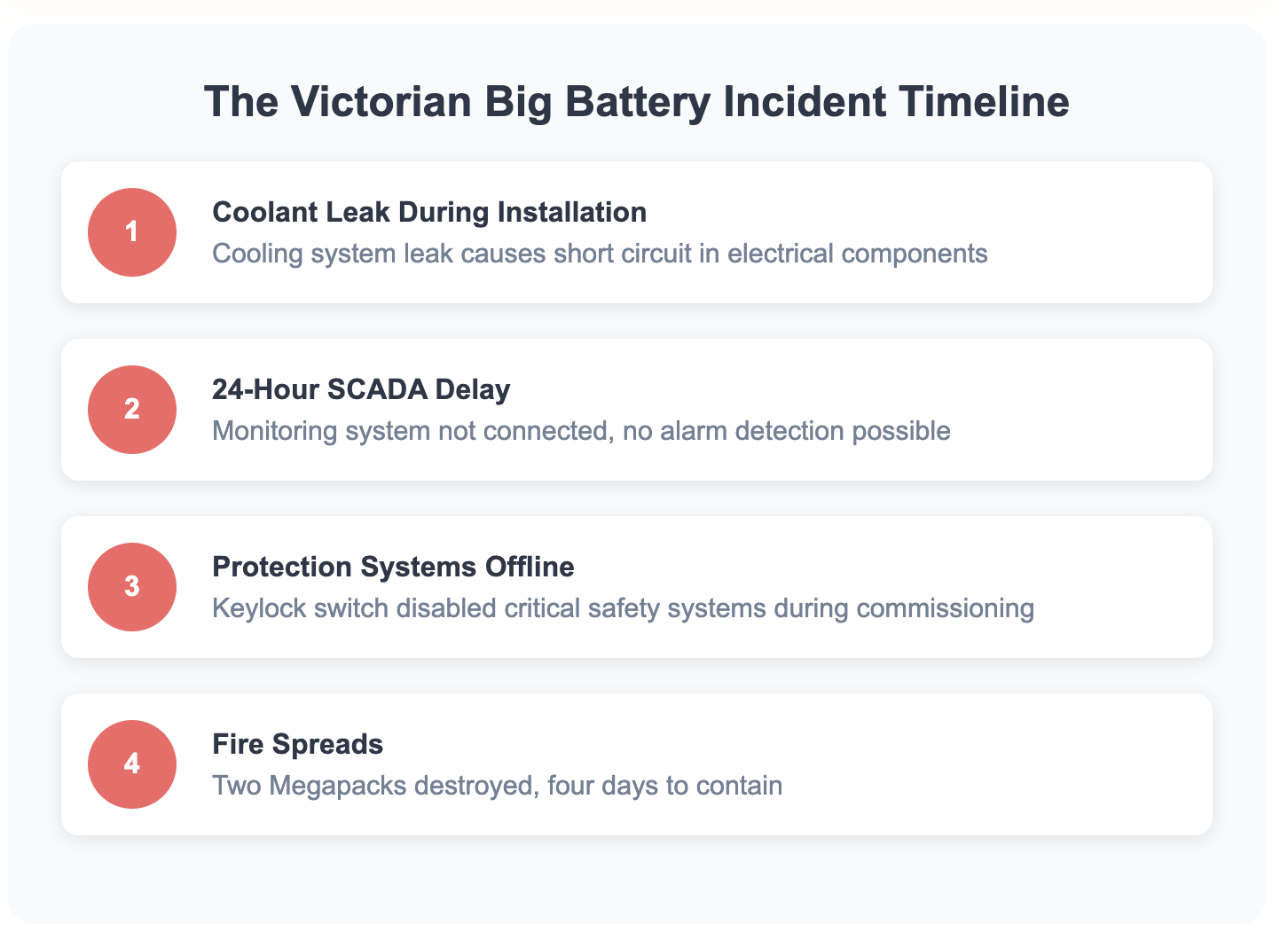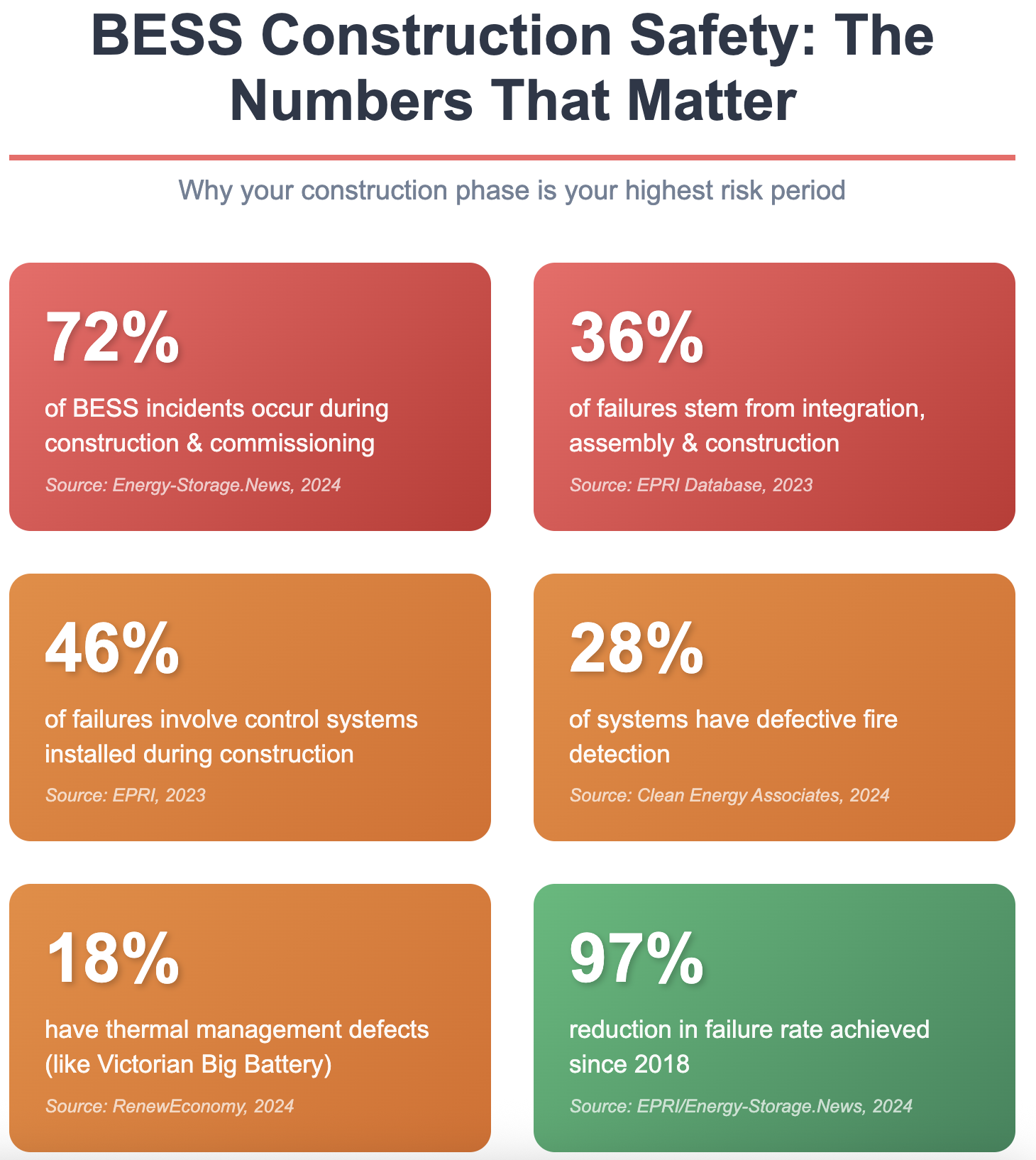Major BESS developers are managing gigawatt-scale installations globally. Teams are installing cooling systems, wiring control panels, and commissioning units at unprecedented scale. Yet this expansion coincides with the industry's highest-risk period: the phase where 72% of all BESS incidents historically strike.
Here's the paradox: while the industry has made remarkable safety improvements, it's still not the battery cells that pose the greatest risk. It's the integration work happening on construction sites.
The Victorian Big Battery Wake-Up Call
When Tesla's Victorian Big Battery caught fire during commissioning in July 2021, it wasn't a faulty battery cell that started it. A coolant leak during installation caused a short circuit. But here's the kicker: the SCADA system had a 24-hour connection delay, and the keylock switch had disabled critical safety systems. Two Megapacks burned for four days before firefighters contained the blaze (Energy Safe Victoria, 2021).
This wasn't an isolated incident. It was a symptom of a systemic problem.

The Numbers Tell a Critical Story
The Electric Power Research Institute's (EPRI) comprehensive failure database reveals an important truth: 36% of BESS failures stem from integration, assembly, and construction work – not from the batteries themselves (EPRI, 2023). The breakdown is revealing:
- 46% of failures involve control systems installed during construction
- 43% involve balance-of-system components like wiring and cooling systems
- Only 11% involve the battery cells themselves (EPRI, 2023)
Clean Energy Associates' 2024 factory audits across 70+ facilities found that system-level defects have increased to 72% of all identified defects, up from 48% the previous year (Clean Energy Associates, 2024). These construction-phase vulnerabilities include:
- 28% of systems have fire detection defects—sensors that don't respond, alarm buttons that malfunction
- 19% have faulty auxiliary circuit panels risking system failure
- 15-18% have thermal management defects—the same issue that caused the Victorian Big Battery incident (Clean Energy Associates, 2024; RenewEconomy, 2024)

The Subcontractor Challenge
Here's a critical consideration for large-scale operations. Half of all BESS problems occur during site work – precisely when the workforce is dominated by subcontractors (RenewEconomy, 2024). These aren't core team members embedded in a company's safety culture. They're often temporary workers facing tight deadlines and varying levels of familiarity with BESS-specific hazards.
The renewable energy sector needs 167,900 additional workers, with a projected global shortfall of 7 million skilled workers by 2030 (Adecco, 2024). The industry is hiring rapidly, with compressed training timelines. This creates a fundamental challenge: maintaining safety excellence while scaling at unprecedented speed.
The Evolution Beyond Traditional Safety Programs
The industry has made significant strides in safety: the 97% reduction in failure rates since 2018 proves that. Traditional compliance-based safety programs have established essential foundations: procedures, standards, and accountability systems. These have been crucial in eliminating many hazards.
But here's where Self-Determination Theory offers the next leap forward. Traditional programs often create what psychologists call "controlled motivation": workers who follow rules primarily when monitored. Research shows this approach has limitations: controlled motivation is actually negatively correlated with safety behaviour (Self-Determination Theory research, 2023).
The challenge intensifies during commissioning when monitoring systems aren't fully online. Workers operate with reduced oversight during the highest-risk phase. The Victorian Big Battery had its protection systems offline during commissioning – a common practice that proved costly. This is where intrinsic motivation becomes critical.
The Recognition Advantage: Building on Success
Leading companies are discovering that recognition-based safety programs can amplify existing safety improvements. The results are compelling:
- 26% reduction in injuries in year one, rising to 69% by year five (Behaviour-Based Safety meta-analysis, 2023)
- Safety compliance rates improving from 62% to over 90% (Construction industry study, 2023)
- Two departments in a Chinese construction company saw safety indexes rise from 70% and 78% to 96% and 99% during implementation (BBS implementation study, 2023)
These aren't marginal improvements. They represent the difference between good and exceptional safety performance – particularly crucial during construction phases.

What Recognition Does That Rules Don't
Recognition programs based on Self-Determination Theory create "autonomous motivation" — workers who value safety because they believe in it, not because they fear punishment. Research shows autonomously motivated workers:
- Continue safe behaviours without supervision (exactly what you need during commissioning)
- Take initiative to identify and solve problems before they cascade
- Show pride in quality work that prevents those cooling system leaks
- Persist through challenges when deadlines pressure them to cut corners (SDT research compilation, 2023)
A recent study found that providing rewards resulted in safety compliance rates of 75.7% versus 71.1% for penalties, with rewards showing a steeper improvement trend throughout work cycles (Safety incentive comparison study, 2023).

The Gigawatt-Scale Reality
Let's consider the implications for major installations. A typical 1 GWh project under construction faces significant statistical exposure:
- Up to 280 MWh could have fire detection defects
- 190 MWh might have auxiliary circuit problems
- 180 MWh could have thermal management issues
Each represents a potential Victorian Big Battery scenario. Yet here's the encouraging truth: the industry has already demonstrated this is manageable.
The 97% Success Story: A Foundation to Build Upon
The BESS industry has achieved something remarkable: failure rates have plummeted 97% since 2018 through improved construction practices (EPRI, 2023; Energy-Storage.News, 2024). While deployment increased 65-fold, incident rates remained flat. This dramatic improvement demonstrates the industry's capacity for rapid safety evolution.
The companies leading this transformation share a common approach: they've moved beyond compliance to create cultures where workers are intrinsically motivated to identify and address safety challenges. Recognition systems have been central to this shift, transforming construction crews from rule-followers into safety advocates.
The Path Forward: From Good to Exceptional
The industry stands at an inflection point. We've solved many fundamental safety challenges through standards, procedures, and technology. The next frontier is human motivation: creating environments where safety excellence emerges naturally from engaged, empowered workers.
Recognition systems based on Self-Determination Theory offer a proven pathway:
- Immediate recognition during construction reinforces safe behaviours at the neural level
- Peer-to-peer recognition builds the team cohesion essential for complex integration work
- Competence-building feedback helps workers master the precise skills needed for BESS assembly
- Autonomy-supportive leadership develops workers who think proactively, not just comply
This isn't about replacing existing safety systems; it's about amplifying their effectiveness through human psychology.

The Strategic Opportunity
Forward-thinking companies recognise that safety excellence is a competitive advantage. As the industry scales to meet global energy storage demands, those who master construction safety through recognition and motivation will:
- Reduce project delays and cost overruns
- Attract and retain skilled workers in a competitive market
- Build reputations that win contracts
- Contribute to the industry's continued safety improvement
Every gigawatt installed safely strengthens the entire sector's credibility and growth potential.
The Question That Drives Progress
The industry has already achieved a 97% reduction in failure rates. The next challenge is clear: How do we capture that final margin of safety excellence during our most vulnerable phase—construction and commissioning?
The evidence points to recognition-based approaches that create intrinsically motivated workers. With gigawatt-scale projects multiplying globally and the lessons from Victorian Big Battery firmly documented, the business case for comprehensive recognition programs has never been stronger.
The mathematics of safety investment are compelling: recognition programs cost a fraction of a single incident's financial and reputational damage.
Ready to enhance your BESS construction safety? Access our comprehensive BESS Construction Safety Checklist based on Victorian Big Battery investigation findings and discover how recognition-based safety can elevate your construction outcomes.
Because when 72% of incidents happen during construction, continuous improvement isn't optional – it's essential for sustainable growth.










.svg)
